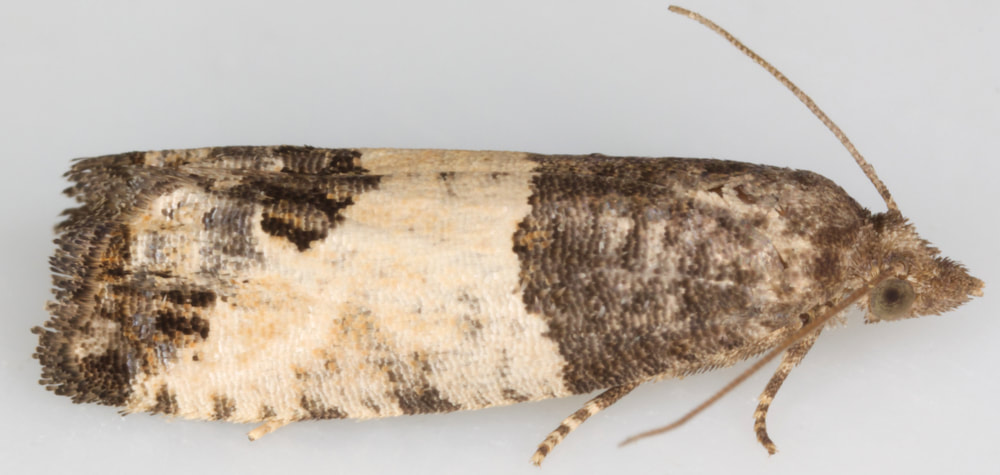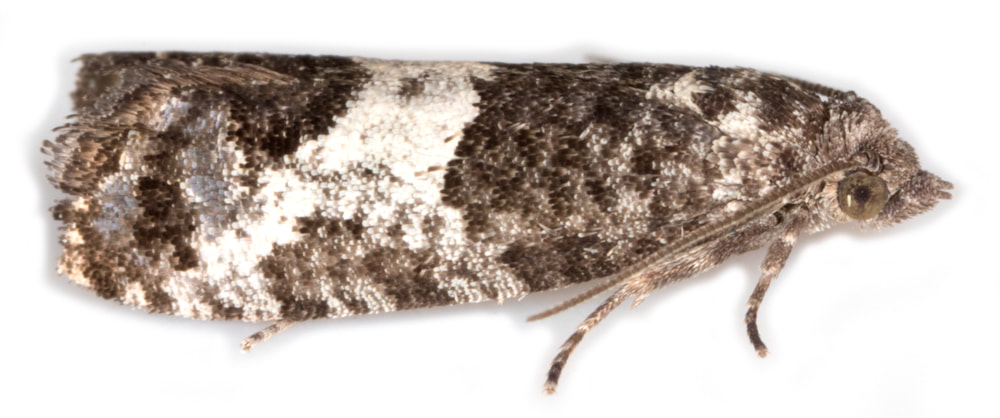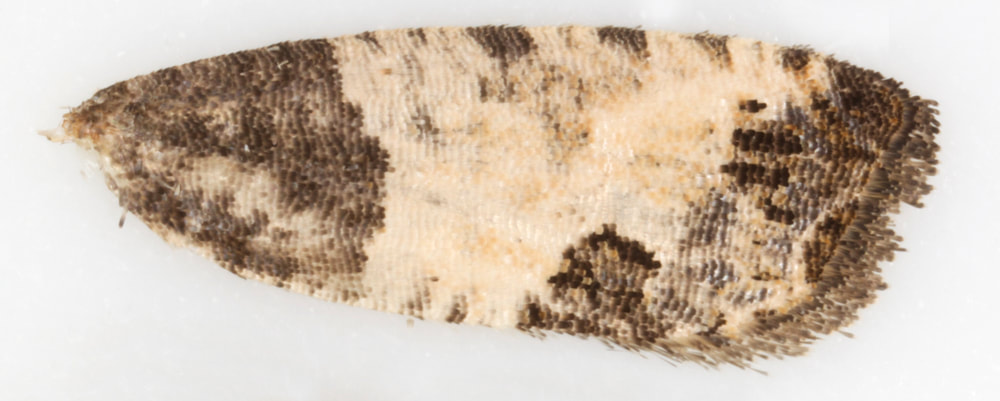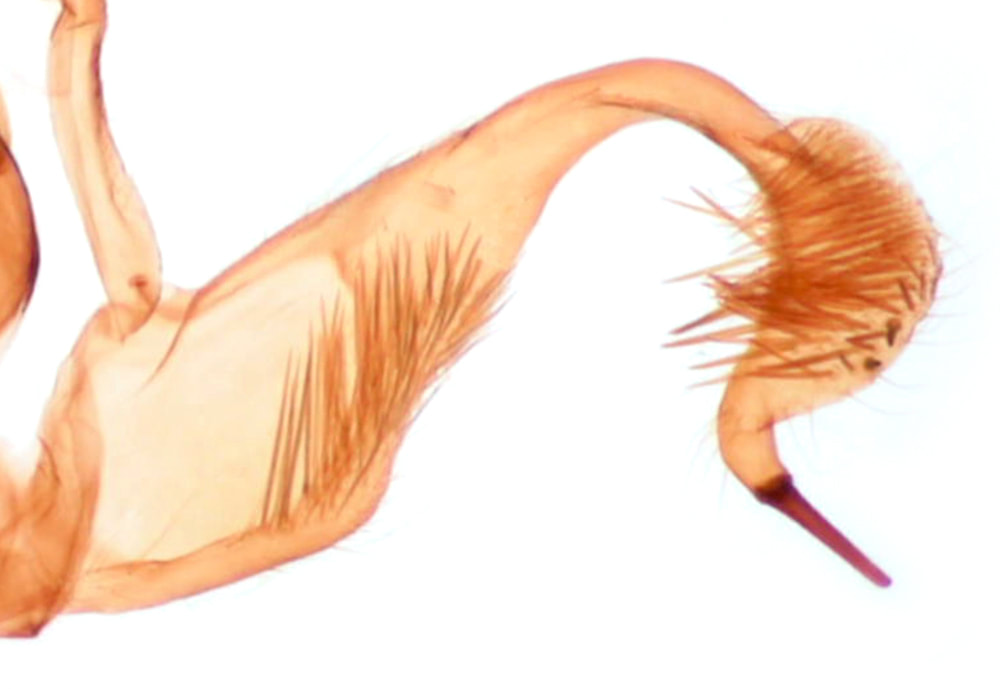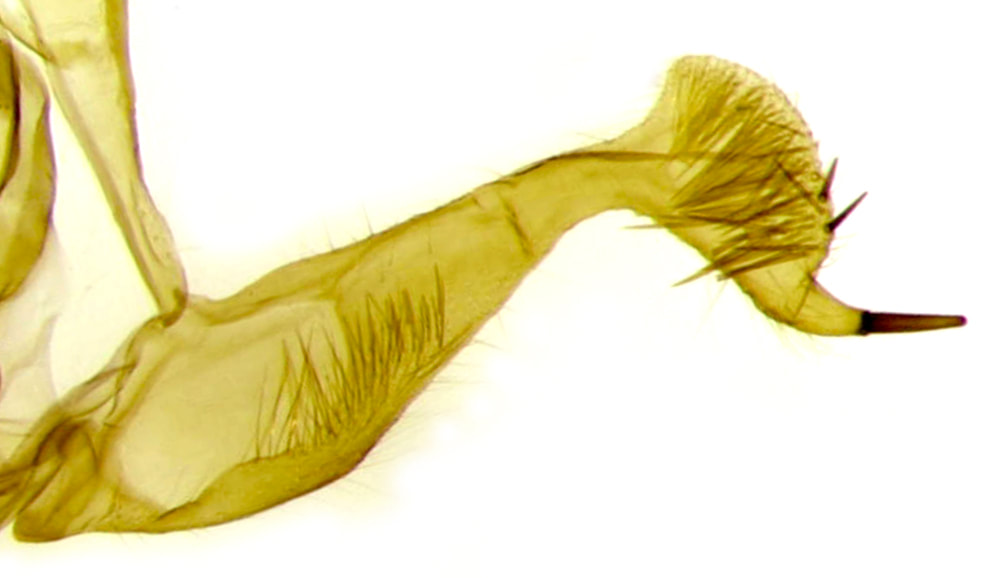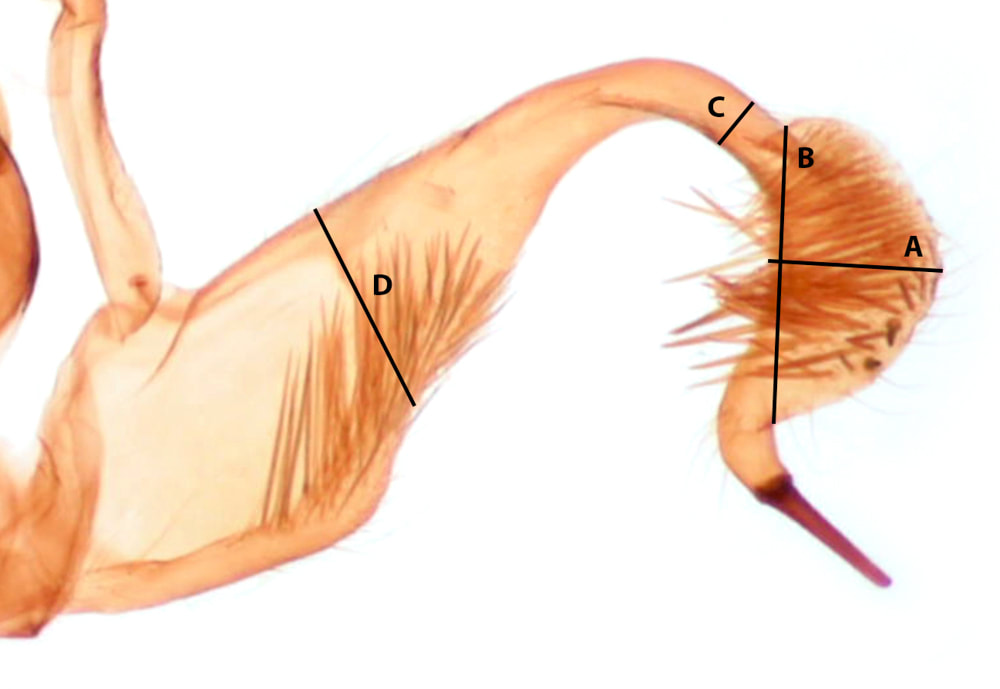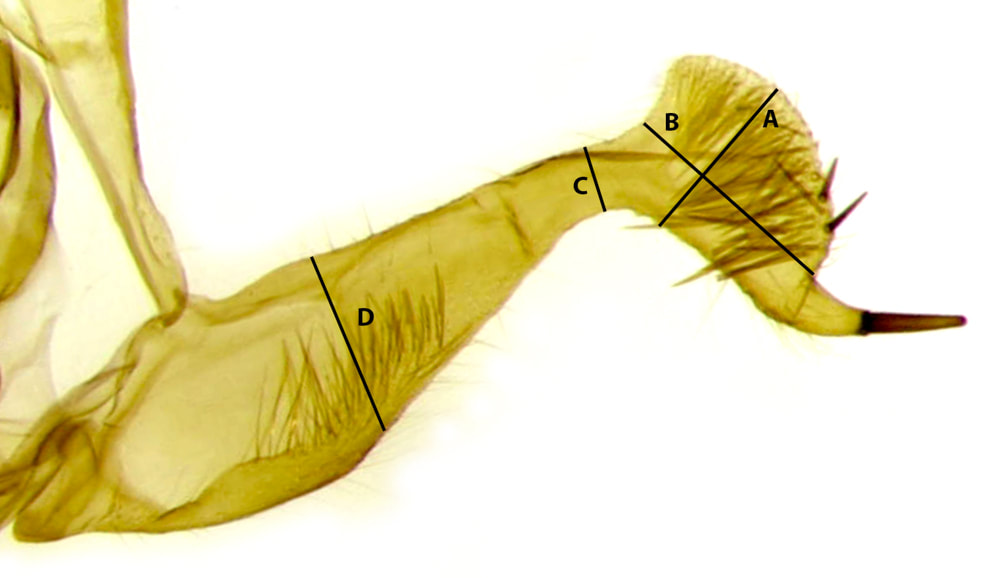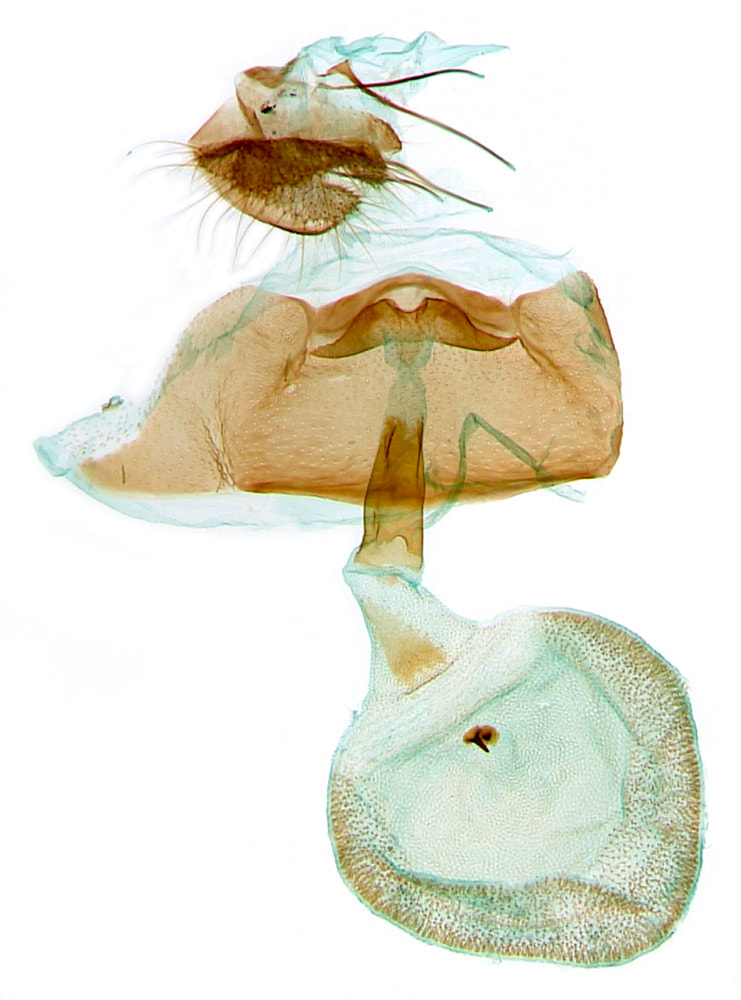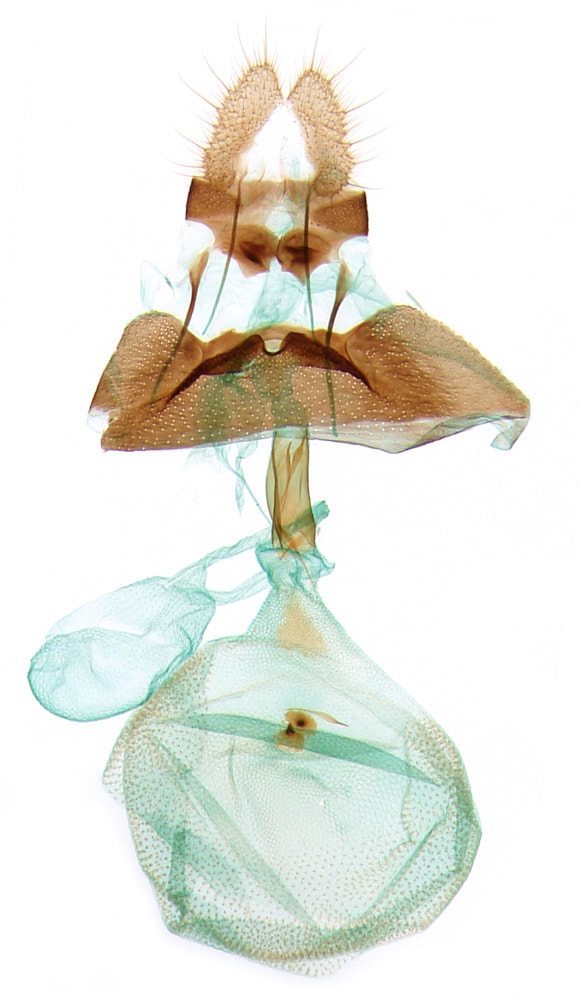Spilonota |
The two species can be very similar. Both have a dark basal patch, a prominent blackish pre-tornal marking, an ocellus containing blackish streaks and the male has a small notch immediately distal to the the antennal scape. The central area of the wing has a pale ground colour, but this is often obscured by a grey suffusion with a strigulate pattern. Where this grey suffusion is absent or minimal the basal patch and pretornal marking appear well-demarcated, where there is significant grey suffusion the basal patch and pretornal marking are less contrastingly distinct. S.ocellana has a wide range of larval foodplant but S.laricana is largely confined to larch.
BTM treats laricana as a form of ocellana. The literature is confusing on separating S.ocellana/laricana.
1. Forewing colour in the area distal to the basal patch and proximal to a line from the pretornal marking to the apex
BTM and MBGBI5.2 give the ground colour of S.ocellana as white to ochreous-white. BTM distinguishes laricana as having "a nearly white ground colour coarsely strigulate with blackish-grey"; MBGBI5.2 states "the ground colour of the forewing is heavily suffused with dark grey and finely striated with blackish-grey"; Clifton & Wheeler gives "the white ground colour replaced with coarse grey-black markings" and Sterling & Parsons "more greyish with black markings". From this, I think it can be concluded that specimens with an ochreous tinge to the ground colour should be S.ocellana; but the species are not distinguished on this feature where the ground colour is white with or without grey suffusion or where there is a heavy grey suffusion obscuring the ground colour.
2. Forewing length:breadth ratio
BTM, Clifton & Wheeler and Sterling & Parsons all state that S.laricana has a relatively narrow forewing (MBGBI5.2 does not mention this feature) - The drawings in BTM and the photographs in Clifton & Wheeler do not show any difference in wing length:width ratios between these species by eyeball or measurement. Sterling and Parsons state that separation on wing breadth is unreliable. Although Clifton & Wheeler state "S.ocellana ... can be separated by the broader forewing" they also state that "this can be hard to discern with lone examples". In my own material, I have 6 images of flattened wings of S.ocellana - these have wing ratios of 2.70, 2.75, 2.75, 2.75, 2.77 and 3.01; and just three that I have identified as S.laricana - 2.90, 2.88 and 2.86. If this is a reliable means of separating these species then the specimen identified as S.ocellana with a wing ratio of 3.01 (§10) should be reidentified as S.laricana. This feature is unlikely to be of value in separating live moths.
BTM treats laricana as a form of ocellana. The literature is confusing on separating S.ocellana/laricana.
1. Forewing colour in the area distal to the basal patch and proximal to a line from the pretornal marking to the apex
BTM and MBGBI5.2 give the ground colour of S.ocellana as white to ochreous-white. BTM distinguishes laricana as having "a nearly white ground colour coarsely strigulate with blackish-grey"; MBGBI5.2 states "the ground colour of the forewing is heavily suffused with dark grey and finely striated with blackish-grey"; Clifton & Wheeler gives "the white ground colour replaced with coarse grey-black markings" and Sterling & Parsons "more greyish with black markings". From this, I think it can be concluded that specimens with an ochreous tinge to the ground colour should be S.ocellana; but the species are not distinguished on this feature where the ground colour is white with or without grey suffusion or where there is a heavy grey suffusion obscuring the ground colour.
2. Forewing length:breadth ratio
BTM, Clifton & Wheeler and Sterling & Parsons all state that S.laricana has a relatively narrow forewing (MBGBI5.2 does not mention this feature) - The drawings in BTM and the photographs in Clifton & Wheeler do not show any difference in wing length:width ratios between these species by eyeball or measurement. Sterling and Parsons state that separation on wing breadth is unreliable. Although Clifton & Wheeler state "S.ocellana ... can be separated by the broader forewing" they also state that "this can be hard to discern with lone examples". In my own material, I have 6 images of flattened wings of S.ocellana - these have wing ratios of 2.70, 2.75, 2.75, 2.75, 2.77 and 3.01; and just three that I have identified as S.laricana - 2.90, 2.88 and 2.86. If this is a reliable means of separating these species then the specimen identified as S.ocellana with a wing ratio of 3.01 (§10) should be reidentified as S.laricana. This feature is unlikely to be of value in separating live moths.
Male genitalia: A substantial difficulty with this genus is that in the natural state the valva is in-curved at the neck and rotated through ~90° at the cucullus, making it difficult to get the genitalia to lay flat in a consistent fashion. Differences between S.ocellana/laricana are subtle and there is individual variability that may also make assessment problematic. Several examples of both species are shown at Moth Dissection.
1. Cucullus
At Moth Dissection one image of each species is labelled to suggest that the dorsal lobe of the cucullus is short and rounded in S.laricana, longer and more ovoid in S.ocellana. This relative statement can be expressed in more absolute terms by taking the ratio of the broadest width of the cucullus (A in the images below) to the length of the dorsal lobe of the cucullus (B in the images below). For the Moth Dissection images the ratios are in the range 0.59-0.67 for S.ocellana and 0.68-0.86 for S.laricana.
2. Neck
Another feature that appears to be consistent, but which is not labelled at Moth Dissection, is that the neck at the point of junction with the cucullus appears significantly broader in S.laricana. Whilst it is fairly straightforward to measure the neck at its narrowest point (C in the images below) once it is satisfactorily laid flat, it is more problematic to obtain an accurate measurement to create a ratio that can provide a reliable means of comparing different specimens - I have taken the width of the valva at the lateral margin of the basal cavity (D in the images below), but recognise that this is not as precise a measure as would ideally be desirable. For the Moth Dissection images the ratios are in the range 0.24-0.29 for S.ocellana and 0.38-0.46 for S.laricana.
A further feature, labelled in one of the Moth Dissection S.laricana images, states that the "caudal edge of the sacculus is indistinct"; this labels what I would term the ventral margin of the sacculus, and I can see neither that it is "indistinct" nor that it differs convincingly from S.ocellana.
In the drawings in MBGBI5.2 S.ocellana is drawn with a more angular ventral valval margin, which is consistent with the images of my specimens below, but this feature would not provide a means of differentiation when comparing the images at Moth Dissection.
1. Cucullus
At Moth Dissection one image of each species is labelled to suggest that the dorsal lobe of the cucullus is short and rounded in S.laricana, longer and more ovoid in S.ocellana. This relative statement can be expressed in more absolute terms by taking the ratio of the broadest width of the cucullus (A in the images below) to the length of the dorsal lobe of the cucullus (B in the images below). For the Moth Dissection images the ratios are in the range 0.59-0.67 for S.ocellana and 0.68-0.86 for S.laricana.
2. Neck
Another feature that appears to be consistent, but which is not labelled at Moth Dissection, is that the neck at the point of junction with the cucullus appears significantly broader in S.laricana. Whilst it is fairly straightforward to measure the neck at its narrowest point (C in the images below) once it is satisfactorily laid flat, it is more problematic to obtain an accurate measurement to create a ratio that can provide a reliable means of comparing different specimens - I have taken the width of the valva at the lateral margin of the basal cavity (D in the images below), but recognise that this is not as precise a measure as would ideally be desirable. For the Moth Dissection images the ratios are in the range 0.24-0.29 for S.ocellana and 0.38-0.46 for S.laricana.
A further feature, labelled in one of the Moth Dissection S.laricana images, states that the "caudal edge of the sacculus is indistinct"; this labels what I would term the ventral margin of the sacculus, and I can see neither that it is "indistinct" nor that it differs convincingly from S.ocellana.
In the drawings in MBGBI5.2 S.ocellana is drawn with a more angular ventral valval margin, which is consistent with the images of my specimens below, but this feature would not provide a means of differentiation when comparing the images at Moth Dissection.
Female genitalia: I have not yet come across any information separating S.ocellana/laricana
Both species show a notched posterior margin to the ventral plate of A7 at the ostium; a short ductus bursae sclerotised over much of its length; a separate sclerotisation in the ventral wall at the junction of the ductus and corpus bursae; and 2 small thorn-like signa. Comparing images at Moth Dissection and drawings in MBGBI5.2 it is possible that the sclerotisation at the junction of the DB and BC is broader and more diffuse in S.laricana. I await examination of further material.
Both species show a notched posterior margin to the ventral plate of A7 at the ostium; a short ductus bursae sclerotised over much of its length; a separate sclerotisation in the ventral wall at the junction of the ductus and corpus bursae; and 2 small thorn-like signa. Comparing images at Moth Dissection and drawings in MBGBI5.2 it is possible that the sclerotisation at the junction of the DB and BC is broader and more diffuse in S.laricana. I await examination of further material.
Page published 18/08/2019
